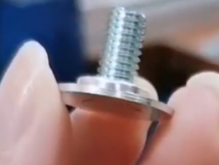This video shows what round studs look like before being welded on:
View attachment 32797
I am curious if anyone else has input on or experience with these welded on studs. Amy at Luyuan said they are starting to offer this service and I am considering it for the EVE LF105 cells due to concern over the m4 threading. She said they haven't laser welded the 105's yet so I would be a guinea pig.
An internal resistance test through the welded connection compared to a normal IR test would be nice to see. I will try to make that happen when they get the new cells in. She is going to send pictures of their studs to me when available.



